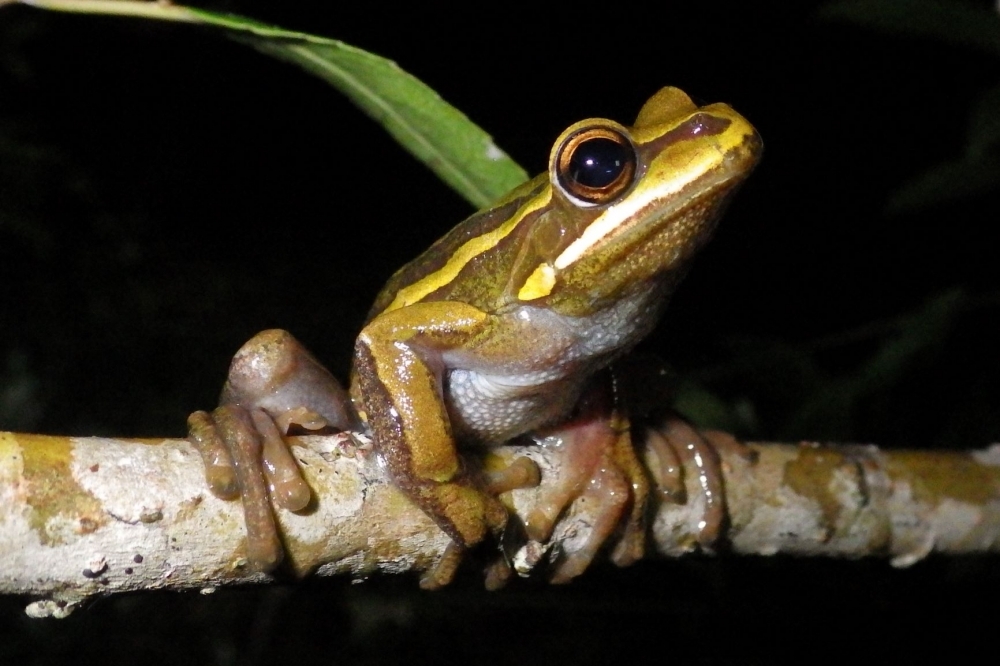


Updated survey of anuran amphibians that live in South America was led by a Brazilian researcher. Results are published in a book with maps of species diversity, ecological functions and endemic species (Boana joaquini, species of tree frog endemic to the southern region of Brazil; photo: Tiago Gomes dos Santos)
Published on 05/04/2021
By André Julião | Agência FAPESP – Brazilian researchers have completed the most comprehensive survey to date of South American anurans – short-bodied tailless amphibians such as toads, frogs and tree frogs – comprising 2,623 species. The study was supported by FAPESP and resulted in the book Biogeographic Patterns of South American Anurans, published last September by Springer.
The book updates the number of species recorded to 2,017 and includes maps of species diversity, ecological functions, phylogenetic diversity (different evolutionary lineages) and endemic species. The information will be highly useful in the formulation and management of conservation policies.
The last survey of this kind was published in 1999, in a book edited by William E. Duellman, Professor Emeritus of the University of Kansas (USA), and entitled Patterns of Distribution of Amphibians: A Global Perspective. He recorded 1,644 South American species. The book included several maps showing how this diversity was distributed. In times prior to GIS technology (geographic information system), he had scant resources to analyze the ecological and evolutionary processes that produced the patterns observed. For the new book, the Brazilian group compiled information from several databases and the scientific literature produced on the subject to date. In addition, the use of GIS tools enabled the researchers to perform more extensive analyses than those by Duellman.
“Although several studies have been conducted since that last survey, they all focused on a specific group of anurans or one or another region of South America,” said Tiago da Silveira Vasconcelos, a postdoctoral fellow of São Paulo State University’s School of Sciences (FC-UNESP) at Bauru and first author of the book.
Vasconcelos did some of the research as part of the project “Macroecology of anuran amphibians from Cerrado and Atlantic Forest: species distribution modelling, influence of climate changes and priority areas for conservation”, which is a contribution to the FAPESP Research Program on Global Climate Change (RPGCC).
The other authors were Fernando Rodrigues da Silva, a professor at the Federal University of São Carlos’s Science and Technology for Sustainability Center (CCTS-UFSCar) at Sorocaba; Tiago Gomes dos Santos, a professor at the Federal University of the Pampa (UNIPAMPA); Vitor H. M. Prado, a professor at the University of Goiás; and Diogo Borges Provete, a professor at the Federal University of Mato Grosso do Sul (UFMS).
Forests and mountains
The survey confirmed the evidence found in previous research that the most diverse parts of South America are western Amazonia and the Atlantic rainforest in Southeast Brazil. Diversity is high in these areas due to the joint presence of forests and mountains. Western Amazonia is close to the Andes and the Atlantic rainforest to the Serra do Mar range (which stretches between the states of Rio de Janeiro and Rio Grande do Sul) and to the Serra da Mantiqueira range (whose area covers parts of São Paulo state, Rio de Janeiro state and Minas Gerais state).
“Tropical forests associated with hilly terrain produce considerable diversity of species and ecological functions. For this reason, they’re extremely important to the conservation of anurans throughout South America,” Vasconcelos said.
However, the authors stress that relatively species-poor areas such as the Cerrado (the Brazilian savanna), also require attention, given the key role played by frogs and toads in ecosystem services such as energy and nutrient cycles, as well as agricultural pest control. A significant proportion of Brazil’s agricultural output comes from the Cerrado.
“Conservation of anuran species, even if they’re common and widely distributed, is of paramount importance to maintain food webs,” Vasconcelos said. “They assure natural control of crop pests and mosquitos that transmit dengue, yellow fever and chikungunya, for example. A drastic reduction in anurans would probably lead to outbreaks of disease in humans and crops.”
Species-poor regions are not home only to common species, he added. In the central and southern parts of the Andes, for example, phylogenetic diversity is high, and there are many endemic species.
“Our study offers guidance for researchers who go into the field to try to find out what made this pattern appear in evolutionary terms. It’s important to conserve these areas to not lose the evolutionary heritage of life’s history on Earth,” he said.
The study was also supported by FAPESP via a Young Investigator grant awarded to the project “Influence of ecological and evolutionary processes in structuring amphibian communities at different spatial and temporal scales”, for which the principal investigator was Fernando Rodrigues da Silva, and the project contributed to the FAPESP Research Program on Biodiversity Characterization, Conservation, Restoration and Sustainable Use (BIOTA-FAPESP), and via a postdoctoral scholarship awarded to Diogo Borges Provete.
All the book’s authors were supported by FAPESP as graduate students at São Paulo State University’s Institute of Biosciences, Letters and Exact Sciences (IBILCE-UNESP) at São José do Rio Preto. They were supervised by Professor Denise de Cerqueira Rossa-Feres, to whom the book is dedicated.
Title: Biogeographic Patterns of South American Anurans
Authors: Tiago S. Vasconcelos, Fernando R. da Silva, Tiago G. dos Santos, Vitor H. M. Prado, Diogo B. Provete
Pages: 160
More information: link.springer.com/book/10.1007/978-3-030-26296-9.
Source: https://agencia.fapesp.br/32028